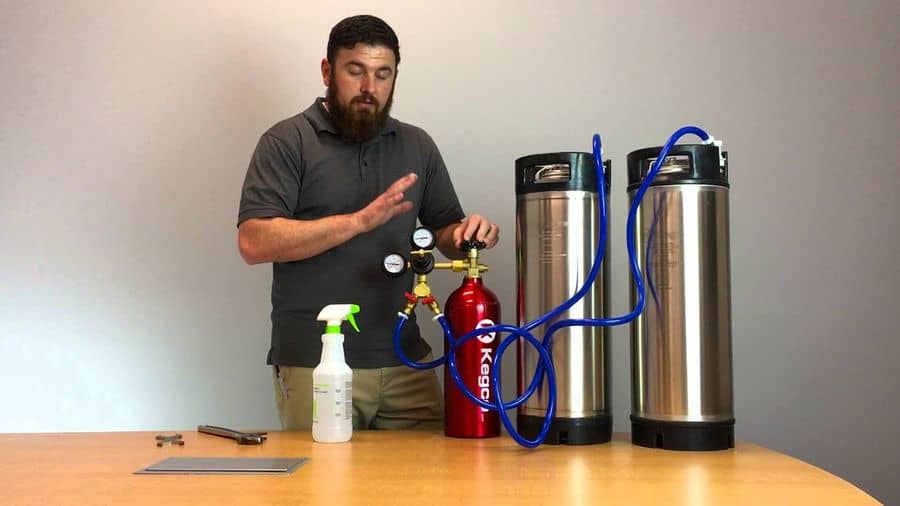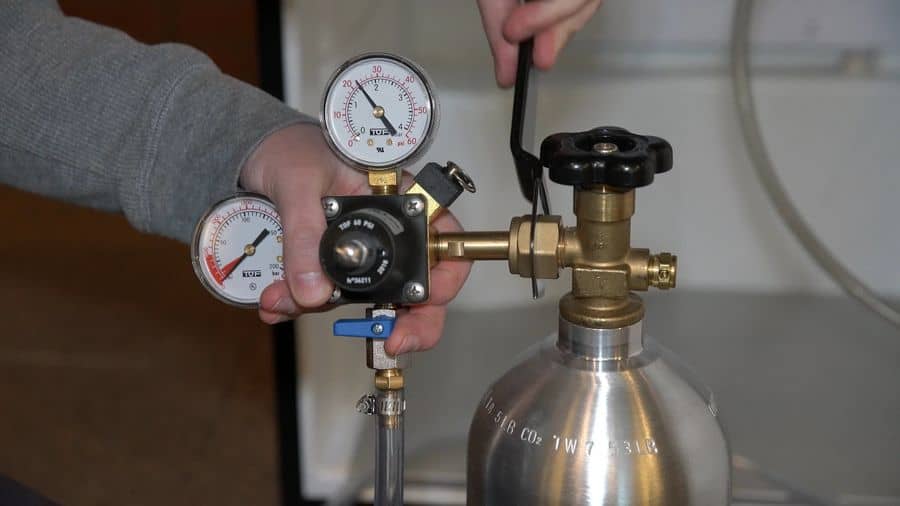How do you use an air compressor to refill a CO2 tank? A CO2 tank has several purposes, including aquariums uses, and soda machines, thus it must be filled and refilled on a routine basis. It’s not as tough as it appears to empty and refill a CO2 tank. All you need are the necessary tools and some understanding of how to use them to refilling CO2 tank.
The most significant instrument for emptying and replenishing the Co2 tank is an air compressor. You won’t have to go to the store to fill and refill the Co2 tank if you use an air compressor. An air compressor is a low-cost solution to keep your CO2 tank supplied and to inflate your pool easily.
We’re about to address the question, “How do you refill a CO2 tank with an air compressor?” Also, here is the CO2 tank manual guide, if required. Let’s proceed to the next step.
What Is the Best Way to Refilling a Co2 Tank at Home?
Finding the Perfect Match
The first step is to ensure that the Co2 tank is properly fitted. To provide you with better control while filling the Co2 tank, the air compressor hose should fit properly to the Co2 tank fitting.
To begin, join the two sections together, then securely screw the other end into the Co2 tank.
The fittings on certain Co2 tanks and air compressor tanks differ to help you avoid mixing the wrong gas with the proper one. You’ll need an adapter for those tanks since it will allow you to connect the CO2 tank like a compressed air tank.
The Co2 Tank Is Being Drained
To remove all the air in the tank, unscrew the bleed valve on the top of the fitting after securing the pieces snugly and safely. Remember to close the bleed valve again before turning on the compressor and filling the Co2 tank.
After the old air has been emptied, you may replenish the Co2 tank with new air from the air compressor, which will be more precise.
Adding Co2 to the Tank
This procedure is divided into two parts:
-
Calculating Size and Time:
Before turning on the air compressor, determine how big your Co2 tank is and how long it will take to replace it. This will tell you how much air to add, and overfilling your Co2 tank will harm it.
To begin, determine the size of your CO2 tank and multiply it by two. You will be given a number representing the length of time required to fill it up. The compressor must run for a certain amount of time.
For example, if the tank is 10 ounces incapacity, it will take 20 seconds to fill with air. Those seconds must be precisely counted. To set your timer on them, you’ll need either a wristwatch or a smartphone.
-
Starting the Air Compressor:
At this point, all you have to do is start the air compressor and keep a close eye on the seconds. The most crucial aspect of the procedure is keeping track of time. Any additional air would be extremely harmful and cause major issues.
Final Touches
There’s only one more step left to complete the procedure. It’s time to switch off the air compressor once you’ve used it for a reasonable period and the tank is safely filled. But you don’t just close it when the timer runs out. To avoid any build-up, open the valve and allow a few seconds for any lines to be removed.
Finally, you’re finished. You may securely detach the air compressor line from the Co2 tank. You’ve done an excellent job, saving both money and energy. You may now use it as many times as you want without fear of running out.
What Kinds of Safety Measurements Should You Be Concerned About?
As we know CO2 is a volatile material. Therefore be sure to follow all safety precautions while filling CO2 canisters in your garage or shop.
You’ll want to be very careful about preserving safety so that you don’t end up with an injury.
- A CO2 tank should never be dropped.
- A CO2 tank should never be punctured.
- Keep the tanks away from any combustible substances. This might result in an explosion. Therefore it’s crucial to think about it.
- Make sure you’re concentrating on the filling procedure. Overfilling might result in a dangerous scenario and broken canisters.
- When filling CO2 tanks, make sure no other individuals are present for increased safety.
- Use safety glasses to ensure that your eyes are protected in an accident.
When working in a shop or with compressed air for any reason, you can never be too careful. If you are concerned about maintaining safety, do not fill CO2 tanks in your garage or shop, especially if other people are around.
What Does Hydro-testing Entail?
After the initial test, some smaller tanks may not require a second. These types of tanks must pass this test to ensure that they are safe to use.
This is accomplished by removing all of the air from the tank and filling it with water. To ensure that the tank has the integrity to hold, it is pressured to 1.5 times the rated pressure. This examination reveals any leaks, ruptures, or damage to the tank.
This is testing mandated by law in the United States, and if your tank has not been tested in the previous five years, you must ensure that it is done. This testing may be done in various methods, but they all look for the same defects and problems inside the tanks to ensure that they are safe to use.
Is It Ok to Use Compressed Air in a Co2 Tank?
You may utilize your CO2 tank to store compressed air, but you must ensure that you are correctly filling the tank. The CO2 tank might explode if you make a mistake.
Some individuals do this, although it is not advised for CO2 tanks. You’ll be dealing with a greater pressure within the tank, so factor that into your calculations to avoid injury or damage to the tank you’re filling.
Using an Air Compressor to Refill a Co2 Tank Necessitates Meticulous Attention to Detail.
If you’re going to use your air compressor to replenish your CO2 canisters or tanks at home, follow these instructions carefully.
Several factors might result in injury or damage to the tanks, all of which should be avoided.
If you want to do this with your CO2 tanks, make sure you know everything there is to know about the procedure and that you have the necessary connections for your air compressor before you begin.
If you’re going to use your home compressor to fill CO2 tanks, you’ll need to make sure you’re safe. Before filling CO2 tanks manually, ensure you have the right connections and a good air compressor.
Conclusion
Filling the Co2 tank using an air compressor may be a breeze when you follow the instructions and precautions. Don’t worry; empty the can and restart the operation carefully if something goes wrong.
It’s a lot easier than you would expect to use an air compressor for such a task. Almost anyplace, you may find the greatest air compressor. If you’re filling a Co2 cartridge, you’ll need a high-pressure air compressor; an ordinary one won’t suffice.
Faqs Related to Refilling Co2 Tank With Air Compressor
What Is the Cost of Refilling a Co2 Tank?
The answer to that query is highly dependent on the size of your CO2 tank. The less money you pay, the smaller the tank is. Each refill costs more money the greater the tank is. Each time you fill up your tank, expect to pay anything from $15 to $30. However, the price varies depending on the size.
Learning how to replenish a CO2 tank using an air compressor is an excellent method to save money.
Is It Safe to Refill Co2 Tanks With Air Compressors?
Compressed air is a straightforward and safe way to refill a CO2 tank. However, it is preferable to learn how to do it correctly. The Co2 tank you’re replenishing might explode if you’re not careful. An explosion might hurt you. People in your immediate vicinity may also be harmed. You can also end up causing property damage.
Is It Possible to Fill a Co2 Tank Using a Hand Pump?
Once you’ve drained the air, shut this valve before filling it up. A high-pressure air compressor is required to fill a CO2 cartridge. You can’t fill one with a hand pump or any tire pump since they only go up to 150 PSI. The compressor must be able to deliver the appropriate PSI to meet the tank’s rating.
How Do Compressed Air and Co2 Differ?
Aluminum and steel are used to construct CO2 tanks. Compressed Air tanks with a pressure rating of 3000 psi are typically built of aluminum, whereas tanks with a pressure rating of 4500 psi often have a supporting wrap made of carbon fiber.












